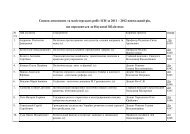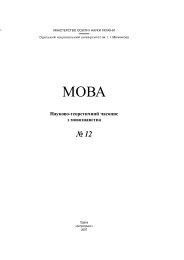Ðип. 26 (2011)
Ðип. 26 (2011)
Ðип. 26 (2011)
Create successful ePaper yourself
Turn your PDF publications into a flip-book with our unique Google optimized e-Paper software.
Pasternak T. A.COMMUNICATIVE STRATEGIES OF ENGLISH «JOB INTERVIEW» ...<br />
The aim of the article is to analyze communicative strategies of English<br />
“job interview” in the context of studying the strategies of positive and negative<br />
politeness.<br />
The concept of “communicative strategy” is investigated in modern linguistics<br />
using different approaches. According to the most common approach “communicative<br />
strategy” is defined as realization of speaker’s intentions, his global<br />
and local aims, “it assumes control and choice of effective turn takings and their<br />
cardinal transformation in concrete situation” [1]. In our opinion this approach<br />
can be named “intentional” as it is connected with understanding the strategy in<br />
the context of realization of addresser’s intention.<br />
Other approach of interpreting communicative strategy is oriented to the<br />
effectiveness of addresser’s strategic program on the addressee as well as on<br />
the communication. This approach can be called “effective” as it is based on the<br />
category of effectiveness which defines communicative strategy proceeding from<br />
its ideal strategic aim: “effective ways to reach communicative objective” [5].<br />
Effective approach is closely connected with cognitive aspect of interpretation<br />
of communicative strategy because the effectiveness of communication in<br />
some way results in influence of one communicant on the perception of the world<br />
of the other communicant. According to the cognitive approach communicative<br />
strategy appears as means of influencing on the world-view of the interlocutor by<br />
language means. “It is “the coercion” over the addresser, directed to the change<br />
of his world-view, to the transformation of his conceptual consciousness” [3].<br />
As we have mentioned above, communicative strategies are investigated by<br />
linguists applying different approaches, but the most universal and popular among<br />
them is studying the strategies of positive and negative politeness. This approach<br />
is based on two theories: the principle of “face and politeness” formulated in 1978<br />
by Penelope Brown and Stephen Levinson [6] and cooperative principle realized<br />
in four conversational maxims: Maxim of Quality, Maxim of Quantity, Maxim<br />
of Relevance, and Maxim of Manner and introduced by the British philosopher<br />
Paul Grice [7]. According to the first theory “politeness” is the expression of the<br />
speakers’ intention to mitigate face threats carried by certain face threatening<br />
acts toward another [8, 6]. Being polite therefore consists of attempting to save<br />
face for another. Positive face was defined in two ways: as “the want of every<br />
member that his wants be desirable to at least some others”, or alternately, “the<br />
positive consistent self-image or ‘personality’ claimed by interactants”. Negative<br />
face was defined as “the want of every ‘competent adult member’ that his actions<br />
be unimpeded by others”, or “the basic claim to territories, personal preserves,<br />
rights to non-distraction--i.e. the freedom of action and freedom from imposition”.<br />
Later, P. Brown characterized positive face by desires to be liked, admired,<br />
ratified, and related to positively, noting that one would threaten positive face<br />
by ignoring someone. At the same time, she characterized negative face by the<br />
299














